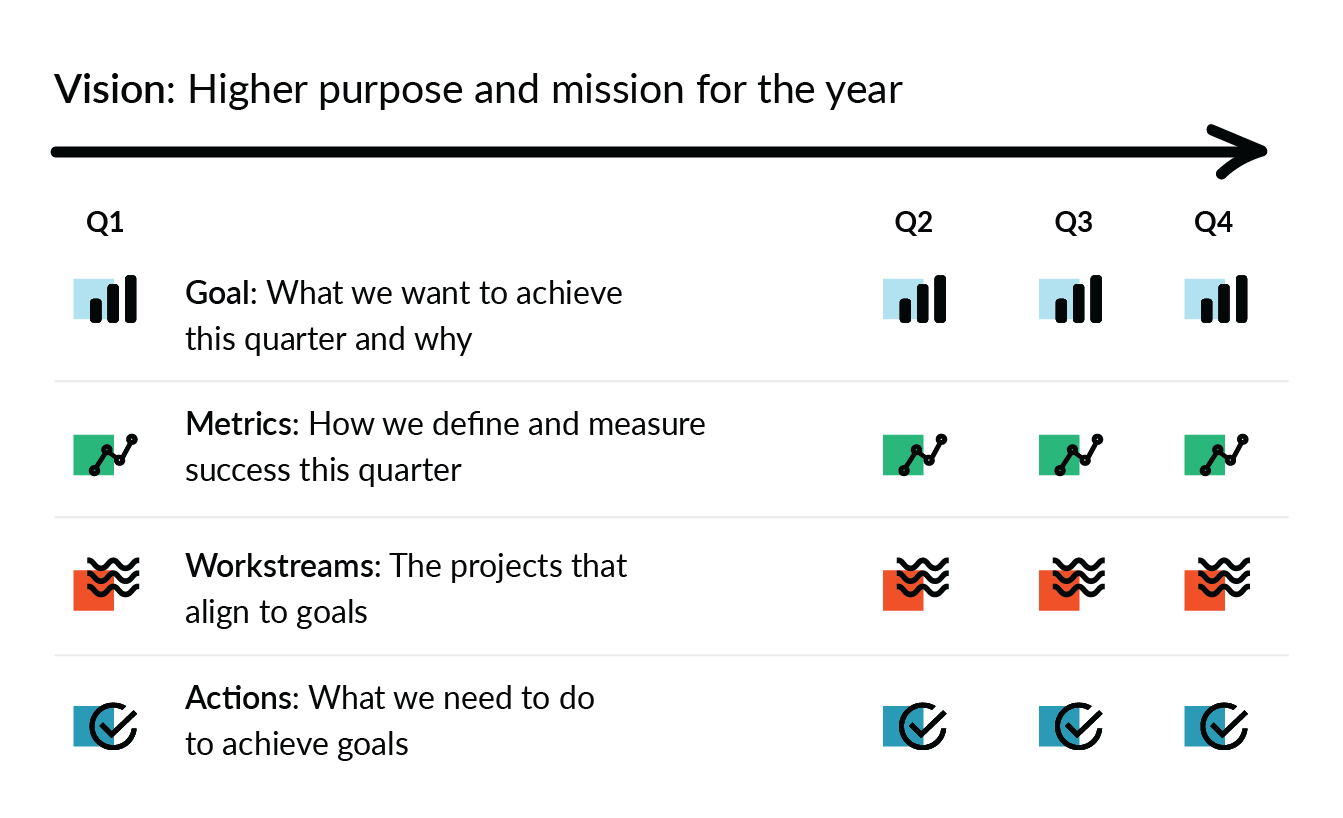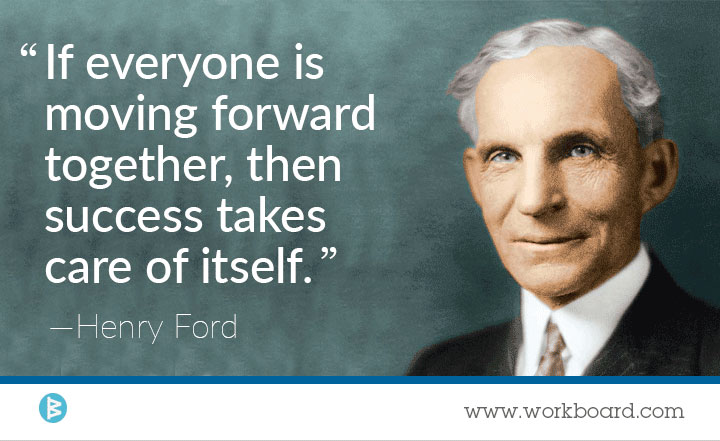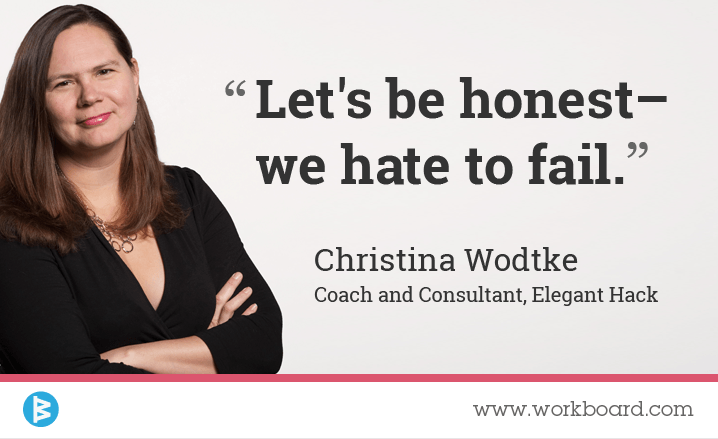If you're ready for an awesome quarter — one where you make a big impact and grow your business or career — start it off right with clear, inspiring quarterly goals that people really care about (not to be confused with the watered-down vague annual goals in the HR system).
Goals should provide immediate purpose, clarity and focal points; they're how and why teams rally to great achievement. With clear short-range goals and OKRs, people make better trade offs as workload increases and things compete for time, as they inevitably do.
In the absence of short-range goals or OKRs, teams are soon adrift in the "sea of incoming" — the next email, the next crisis, the next idea from the boss.
The "next" wave washes away the one before it in a week or two. Without agreed-upon and jointly held goals or OKRs for impact between now and the end of the quarter, it will be difficult to describe or quantify your impact.
A bold, big business quarter
Want to launch into your best quarter ever, but don’t know how to start framing real-time goals? Start by restating your vision, then articulating compelling goals and ambitious metrics. Better yet, implement OKRs this quarter to help your team achieve the best possible results. Use these tips to articulate your vision, goals and metrics and make them real decision drivers this quarter:
1. Step back and think deeply.
What is the mission you’re leading and where do you want to go this year? Whether you do this in an offsite with your exec team, brainstorm with a small team, or do it on a long solo walk, take the time to look at the big picture. Write down your vision statement — make it short, sweet and inspired. Ours is “Help leaders and teams operate at their best and achieve big, bold goals.”
2. Frame and phrase quarterly goals.
Goals (or objectives in the OKR method) are a statement of what you want to achieve rather than what you need to do. Focusing on the next 90 days will actually increase your impact this year. What are the big, bold things you want to accomplish? These are your goals for this quarter. The words you choose should tell people why you're doing something, sustain them when work gets hard, and enable them to describe what they're working on with pride -- the words should matter to them.
Instead of "launch website" try "relaunch our website so people can purchase our products from anywhere." The former sounds like a task and is vague and the latter tells people the purpose of the website relaunch and why it is important.
Instead of "raise NPS score 2 points" try "provide the best service in the world". The former is a metric rather than a goal. The latter tells your team the true goal, inspires them and is what NPS scores measure (a standard measurement of how likely people are to refer others to your company).
3. Use metrics and key results to define success.
Metrics answer the question of how we will know we succeeded in our goals. They should describe great outcomes and tell the team when to declare victory. How much more or less of something will you have if you were successful? Is it sufficient to "launch a website"? Probably not, so metrics like these might define success in the next 90 days on website launch:
launch by 3/15
implement 5 core commerce features
have zero P1 bugs
How would you measure success in the next 90 days on the goal to provide the best service in the world? That might be raising your NPS score 2 points in your core market and measuring in 100% of markets as measures of big bold success this quarter. Metrics tell people where to focus their efforts now.
4. Take the elevator ride test.
When you and your team take an elevator ride with the CEO, everyone should be able to instantly describe their impact in a single sentence. The formula is objective + key results = hero impact.
“We’re re-launching the website so people can purchase our products from anywhere in the world; by March 15, we’ll have 5 new commerce features bug-free and live.”
“I’m transforming candidates’ hiring experience by reducing time to first interview to 7 days, reducing time to offer 5 days and responding to 100% of candidates within 24 hours.”
Bonus: it feels awesome when you can say these things. Double bonus: your elevator pitch works just as well on a resume.
5. Apply the 3 second rule.
Your team should be able to find their OKRs and yours and see progress against them in 3 seconds. That’s about how long it takes to focus on the last message in their inbox — which is your goal’s competition for their time and focus. Our research shows that high performers start their day by looking at their goals and then consciously aligning their time with their aspirations. If you want to be a goal-driven organization, make it easy for everyone to focus on them every day.
6. Go from goals to action.
Now, itemize what needs to get done to achieve your objectives and key results in the remaining 86 days in the quarter (see how that focuses the mind?). What are the big milestones the team needs to hit? Itemize not to micromanage, but to make sure everything necessary is covered, clarify priorities, communicate ownership and give everyone transparency. With execution transparency, you can more easily ensure and predict your results.

7. Thread the needle week after week.
Make OKRs the first topic of short recurring weekly staff meetings. Show the team you’re serious, committed and consistent about achieving them. The more consistently you focus on goals and metrics, the less time you’ll spend in meetings on low level details, dropped balls and priority conflicts. (Trust us on this one.)
8. Cascade and coalesce OKRs.
Use your hero impact statement to validate your quarterly objectives and key results with your boss so you can confidently execute on them. Next, ask your direct reports to set aligned goals and metrics for their teams at the next level of relevant detail. Coach them to see quarter goals as their most powerful communication tools and as a vehicle to operate more efficiently, effectively and independently.
9. Add a leadership growth goal for yourself.
If you follow these 8 steps, you’ll take your leadership game up more than a notch… why not go another notch? Add a private leadership growth goal for yourself too. It might be related to how well or often you communicate, having consistent 1on1s, culture dynamics you want to foster directly or how skillful you are at providing feedback.
From Victory Comes Glory
Like goals to exercise more and a new gym membership, you have to show up to achieve the results you seek. Our data shows a very direct correlation between focus and results; the magic number is 45 minutes a week. Among the thousands of teams using WorkBoard for real-time goals, people who focus on objectives and key results and aligning their actions for at least 45 minutes a week, achieve off-the-chart results. And the results for people who never focus on goals show the exact opposite: no focus, no glory.
How much growth and glory do you want this year? Bring it!









